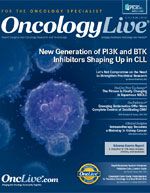Publication
Article
Oncology Live®
Acalabrutinib Challenges Ibrutinib in High-Risk CLL Trial
Author(s):
Patients with relapsed chronic lymphocytic leukemia face a difficult treatment journey, but a phase III safety and efficacy trial involving the second-generation Bruton tyrosine kinase inhibitor acalabrutinib (ACP-196) will help inform oncologists about whether the emerging agent can offer a greater benefit to patients with high-risk disease over ibrutinib (Imbruvica).
John C. Byrd, MD
Patients with relapsed chronic lymphocytic leukemia (CLL) face a difficult treatment journey, but a phase III safety and efficacy trial involving the second-generation Bruton tyrosine kinase (BTK) inhibitor acalabrutinib (ACP-196) will help inform oncologists about whether the emerging agent can offer a greater benefit to patients with high-risk disease over ibrutinib (Imbruvica).
Ibrutinib is indicated for patients with CLL who have had ≥ 1 prior therapy or harbor a 17p deletion. It was approved in February 2014 based on high response rates with few drug-related toxicities.
Researchers have noted, however, that ibrutinib is not without its adverse effects. Further, patients who were given ibrutinib but exhibited a 17p deletion have been shown to have the poorest outcomes. The head-to-head design of this trial has piqued the interest of the oncology community.
This study (NCT02477696) will evaluate acalabrutinib versus ibrutinib in patients with previously treated CLL with a 17p or 11q chromosomal deletion. Patients will be randomized to receive either acalabrutinib orally twice daily or ibrutinib orally once daily. Both treatments are to be taken continuously throughout the study as long as the participant is responding to therapy and not experiencing unacceptable side effects.
The 500-patient trial, which launched in June 2015, has progression-free survival as a primary outcome measure. Incidence of treatment-emergent grade ≥3 infections, incidence of Richter’s transformation, incidence of atrial fibrillation, and overall survival have been designated as secondary outcome measures.
The rationale for the trial was established in a phase I/II study presented at the 2015 American Society of Hematology Annual Meeting by lead author John C. Byrd, MD, and published simultaneously in The New England Journal of Medicine.1,2
Byrd, who is chair of Leukemia Research and director of the Division of Hematology at The Ohio State University Comprehensive Cancer Center, also led the research into ibrutinib. Byrd and colleagues reported that 57 of 60 evaluable patients achieved a partial response to acalabrutinib, including six patients with lymphocytosis, for an overall response rate of 95%. In patients with a 17p deletion (31%), the response rate was 100%.
Elevate CLL Relapsed/Refractory Phase III Study
Acalabrutinib Versus Ibrutinib

ANC indicates absolute neutrophil count; CLL, chronic lymphocytic leukemia; ECOG, Eastern Cooperative Oncology Group; OS, overall survival; PFS, progression-free survival.
“BTK inhibitors are transforming CLL from an incurable to a chronic disease, especially considering that standard CLL therapies typically produce a 35% to 40% response rate in this disease setting,” Byrd said.
Overall, 67% of participants (n = 41) had stage III/IV disease, 46% (n = 28) had bulky lymph nodes ≥5 cm, and 72% (n = 44) had cytopenia at baseline. High-risk prognostic factors included 17p deletion (31%), 11q deletion (29%), and unmutated immunoglobulin heavy-chain variable genes (75%).
The researchers reported that most adverse events (AEs) were grade 1 or 2. The most common grade 1/2 treatment-emergent AEs included headache (43%), diarrhea (38%), increased weight (25%), and upper respiratory tract infection (23%). Severe diarrhea, rash, arthralgia or myalgia, bruising, and bleeding events each occurred in ≤2% of patients.
OncLive
“No drug is without adverse events. With ibrutinib, which is also a great drug, we tend to see more diarrhea, bruising, ecchymosis, and atrial fibrillation. With this drug, all of those adverse events were less. The side effects that stand out with acalabrutinib that are probably different from the other B-cell receptor inhibitors are some headaches, but they generally resolve; they’re not dose-limiting,” Byrd said in an interview with .
There were no reported cases of major hemorrhage or atrial fibrillation. One patient death, which was attributed to pneumonia, occurred during the trial. In addition, researchers reported no incidence of tumor lysis syndrome or pneumonitis, suggesting an improved safety profile compared with ibrutinib, where these toxicities have been reported.
Acalabrutinib has a short half-life, is highly selective for BTK, and only affects two other kinases. This selectivity puts a lot of pressure on BTK, said Byrd. “BTK generally turns over every 24 hours or less, so dosing more frequently, with a more selective inhibitor, might provide the opportunity to be able to treat tumors that are growing quicker,” said Byrd. “That is an advantage of the selective BTK inhibitors.”
These properties suggest that acalabrutinib can be used early in the treatment of CLL, said Byrd, but he added that comparative studies such as the phase III trial will help determine the agent’s place in the treatment paradigm. “As a second-generation BTK inhibitor, ACP-196 is likely going to afford some benefit in other patient populations,” Byrd said. “However, similar to the chronic myeloid leukemia days, Gleevec was a great drug—it’s still a great drug—but we have better TKIs in CML for some patients, and I would put these two drugs in that same class. They’re both great drugs, but ACP-196 probably has some advantages over ibrutinib.”
References
- Byrd JC, Wierda W, Jones J, et al. The Bruton tyrosine kinase (Btk) inhibitor ACP-196: marked activity in relapsed/refractory CLL with a favorable safety profile. Presented at: 2015 ASH Annual Meeting; December 5-8, 2015; Orlando, FL. Abstract 831.
- Byrd JC, Harrington B, O’Brien S, et al. Acalabrutinib (ACP-196) in relapsed chronic lymphocytic leukemia. N Engl J Med. 2016;374(4):323-332.































